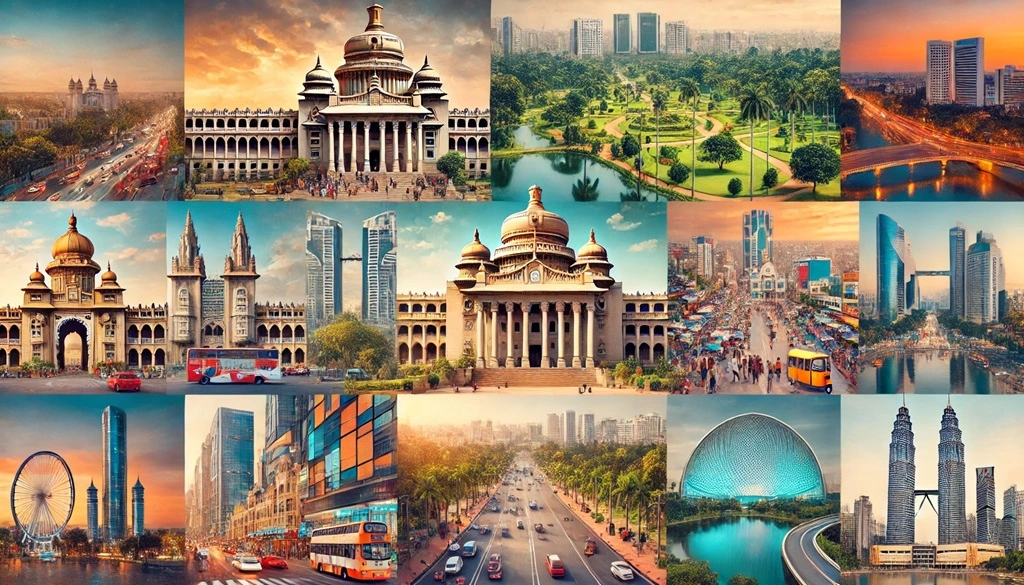Bangalore, now known as Bengaluru, was founded in 1537 by Kempe Gowda I, a feudal lord under the Vijayanagara Empire. The city was initially established as a mud fort and served as a center of trade and governance. Over the centuries, Bangalore has grown into one of India’s most dynamic cities, becoming globally recognized for its IT industry and innovation. Known as the “Silicon Valley of India,” Bangalore has attracted global tech giants and entrepreneurs, making it a hub of technology and startups. But beyond its modern fame, Bangalore holds a rich tapestry of history and culture that dates back centuries.
History of Bangalore
The history of Bangalore city is closely linked with its role as a key administrative and military center in southern India. After its foundation by Kempe Gowda, the city became part of the Mysore Kingdom under the Wodeyars. In the late 18th century, the city saw military confrontations during the Anglo-Mysore Wars, eventually falling under British rule. Over the centuries, Bangalore developed into a cosmopolitan city, becoming a focal point for trade, culture, and education.
When Was Bangalore Divided?
Bangalore was formally divided into two distinct regions in 1809: Bangalore City and Bangalore Cantonment. The division occurred after the British East India Company decided to establish a military base in the region. The Bangalore Cantonment, located northeast of Bangalore City, was built for British soldiers and their families. It became a bustling hub of British colonial life, with European-style buildings, churches, and clubs. Meanwhile, Bangalore City remained under the local administration of the Mysore Kingdom.
The division created two culturally and architecturally distinct areas. The Cantonment had a pronounced British influence, with English being commonly spoken, while the city maintained its native Kannada traditions. After Indian independence in 1947, the two areas were administratively unified, but the cultural differences remain evident today.
Who Is Bangalore Named After?
The name Bangalore is derived from the term “Benda Kaal Ooru”, which translates to “town of boiled beans” in Kannada. According to local legend, during the 12th century, the Hoysala king Veera Ballala II was lost in a forest near the present-day Bangalore area while on a hunting expedition. Weary and hungry, he stumbled upon the hut of an old woman. She kindly offered him boiled beans, and the grateful king named the place “Benda Kaal Ooru” in her honor. Over time, this name was anglicized to Bangalore during British rule.
In 2006, the city officially reverted to its original Kannada name, Bengaluru, as part of a broader movement across India to restore local names and affirm linguistic and cultural identity. The name change was symbolic, marking a return to the city’s roots, though “Bangalore” is still widely used in colloquial speech.
Who Was the Man Who Built Bangalore?
Kempe Gowda I, the founder of Bangalore, was a visionary leader under the Vijayanagara Empire. In 1537, he decided to build a fortified city at the junction of several trade routes, which would serve as a center for commerce and administration. Legend has it that Kempe Gowda was inspired by a dream in which the goddess appeared, instructing him to build the city.
He began the construction of a mud fort, which initially housed markets, religious shrines, and a palace. The fort had eight gates and several watchtowers, some of which still stand today as symbols of Bangalore’s early history. Kempe Gowda also constructed lakes, tanks, and roads to ensure the city had ample water supply and infrastructure. His efforts laid the foundation for the city’s growth over the centuries.
Kempe Gowda was known not just for his architectural foresight but also for his progressive policies. He encouraged the development of trade and commerce, built numerous temples, and promoted religious and cultural harmony. His contributions to Bangalore’s early development earned him a lasting legacy, and his statue near Hebbal Lake stands as a tribute to the city’s founder.
Why Is Bangalore Not a Metro City?
To qualify as a metro city in India, certain criteria must be met. These include a population of over 1 million people, a high level of urban infrastructure, and a significant role in the country’s economy. Metro cities are typically characterized by well-developed transport systems, a large number of industries, and an urban culture that attracts both internal and international migration.
Bangalore, despite being one of the largest and most economically significant cities in India, was not officially considered a metro city for a long time. Before the IT boom in the late 1990s and early 2000s, Bangalore was categorized as a tier-2 city, primarily known for its pleasant climate, parks, and gardens rather than its urban development.
However, with the rise of the IT industry, Bangalore’s population swelled, and it became a major player in India’s economy. Today, it is recognized as a metro city due to its massive population, infrastructure development, and its role as a global tech hub. The city’s metro status is reflected in its growing transportation networks, like the Namma Metro, and its expanding urban sprawl. However, challenges such as traffic congestion, pollution, and inadequate public services continue to affect its growth.
How Can We Help?
At Serenity Hostels, we provide safe and comfortable hostels in Bangalore for working professionals and students alike. Whether you’re looking for a hostel in Bangalore for female students or a hostel in Bangalore for ladies seeking convenience and security, Serenity offers the perfect accommodation. We pride ourselves on being one of the best working womens hostel in Bangalore, providing modern amenities, clean facilities, and easy access to key locations. Choose Serenity Hostels for a stress-free living experience in Bangalore.
FAQs
Which is the oldest area of Bangalore?
The oldest area of Bangalore is Basavanagudi, which is known for its cultural heritage, traditional markets, and iconic landmarks like the Bull Temple.
What is the old name of Bangalore city?
The old name of Bangalore city is Bengaluru, which was anglicized to Bangalore during British rule. The city officially reverted to its original name in 2006.
Who brought IT to Bangalore?
Bangalore’s IT revolution is credited to N. R. Narayana Murthy, the founder of Infosys, and Azim Premji, the chairman of Wipro. These pioneers played a key role in establishing Bangalore as a major IT hub.
Which language is spoken most in Bangalore?
The most widely spoken language in Bangalore is Kannada, although English, Hindi, and Tamil are also commonly spoken due to the city’s diverse population.
Which is the oldest street in Bangalore?
The oldest street in Bangalore is Avenue Road, which dates back to the city’s early days. It remains one of the busiest commercial streets, lined with bookshops, traditional businesses, and historical buildings.

Sridhar Reddy, the innovative entrepreneur behind Serenity Hostels, is a visionary figure redefining hostel culture in Bangalore. As the founder and director of Serenity Hostels, Reddy has not only emphasized the importance of rooms but has also focused on creating a nurturing environment that serves as a second home for students. His sharpness and forward-thinking approach have been pivotal in positioning Serenity Hostels as the premier choice for student accommodation in the city. Reddy’s journey into the world of student hostels began with a clear mission: to transform the traditional hostel experience into something far more enriching and supportive for students away from home.



